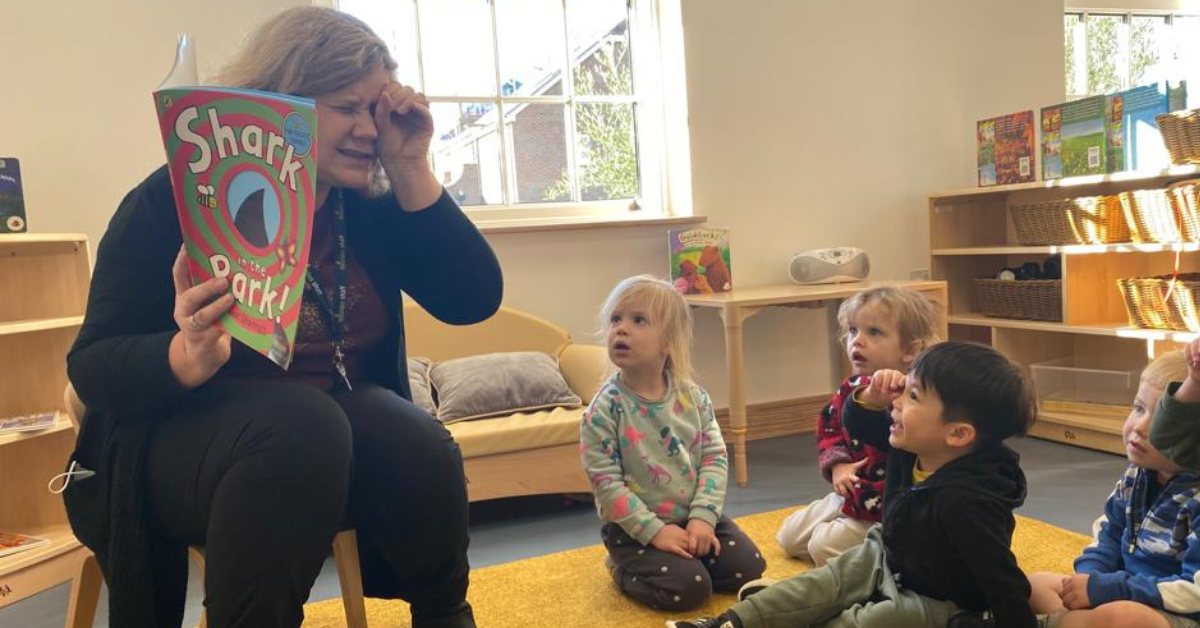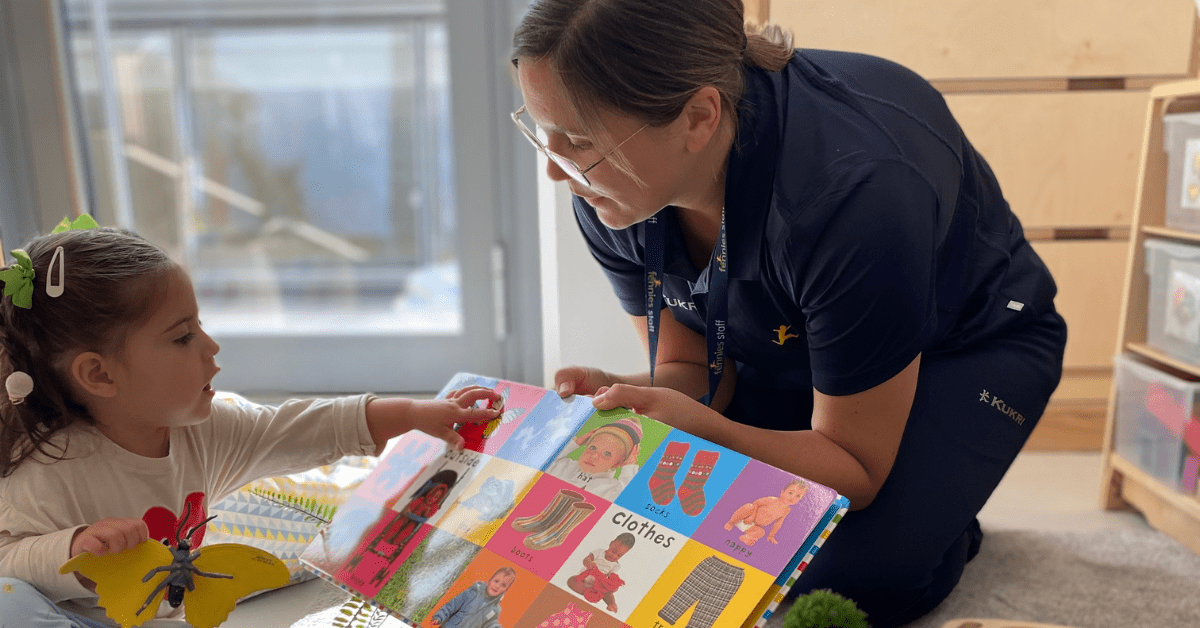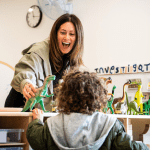

Fennies’ Child Development Expert, Professor Sam Wass, shares his tips on how to start up conversations about books with your baby or toddler to support early reading skills. Sam is a father of two and a child psychologist and neuroscientist best known for Channel 4’s ‘Secret Life of a Four-and Five-Year-Old’s’. Sam provides Fennies with cutting-edge research, which is utilised through our internal staff training, ensuring children get the best education.


Both parents and childcare professionals know that reading is one of the best ways that we can spend time with children during their early years. As well as being enjoyable —we all know that warm, cosy feeling of them sitting on your lap while you read them a story that you loved as a child —there’s also lots of evidence to suggest that reading is massively beneficial for supporting language development and developing children’s comprehension skills. For example, one study tracked children’s long-term outcomes over 28 years and found that, even after taking into account differences in parental education and income, the amount of time that parents spent reading to their child specifically predicted a child’s long-term academic outcomes.
Although we know that supporting early reading skills is something that we want to do, actually managing it can be tricky! I’m sure (I hope) that I’m not the only parent who’s found themselves struggling to read a story while their baby just sits on their lap and tries to eat the book, or shove it up their nose, paying no attention at all to the words that you’re reading or pictures. Or, when my kids were toddlers, they’d often slither off my lap in the middle of page 2, and start jogging laps around the sofa, while I was left just sitting there reading to myself. It takes practice to be able to concentrate on a book – and it’s particularly hard these days when every child is used to hyper-stimulating phones and YouTube. How do you make books feel anywhere near as interesting as the TV?
This blog is for anyone like me who struggles sometimes to get their child to listen and engage with a book. And even if you are lucky enough to have children who will sit still and be read to, then I hope that there will be something in it for you, too, in terms of how to maximise what your child learns and takes away from their time spent reading with you. I draw on the wonderful research by Peter Cooper and Lynne Murray, whose book on babies I’d warmly recommend. These tips are partially based on a brilliant book-sharing intervention for parents that they’ve developed and tested.
First things first, before you even begin telling the story, think about how you sit with the child whilst you’re reading. It’s better to do this somewhere quiet, where there’s no movement happening in your child’s line of sight – because children tend to be more distractible by things like movement and noises than adults are. If they’re somewhere quiet, then it’s just easier for them to stay focused. And if you have a special place where you always go to read, like a book corner or particular chair, then this can help, too.
You need to also get the physical position right. You want to be nice and close to your child because, for many kids, relaxation is contagious. If they can feel the vibrations of your voice, then this can help them to stay calm.


But it’s also worth thinking about where they’re facing. One of the things that’s really important, particularly with younger children, is that you can see where on the page they’re looking so that you can react to this. So, you might want to put them and the book at a bit of an angle on your lap to make this easier.
The next thing to think about is when you read. Reading before bedtime is lovely, and often it’s the easiest time for kids to sit still, but when they’re super relaxed and drowsy they won’t learn as well as when they’re more active and awake during the daytime. And it’s good to be responsive, though, to follow the child’s lead if they come up and ask to read a book, as this is a great sign that they’re in the right state of mind to read.


The next thing to get right before you start reading is your mindset. It’s easy to fall into the trap of thinking of books as something precious - that you should be scared of or gentle with. But for kids looking at books that way almost certainly won’t work – it will just mean that everybody gets stressed.
Babies’ and toddlers’ books are there to get eaten, dribbled on, their pages torn, and so on – and that’s fine! Children will naturally want to play with them, whether it’s turning the pages just for fun, making a big pile to push them over or putting them on their heads and pretending that they’re hats! As long as you only give your child books that can easily be replaced, then it’s most important by far that they’re comfortable and allowed to explore a book in any way that they want.
Another idea to change from the outset, whether you’re a parent or a practitioner teaching reading, is the idea that books need to be read in a set order. Children’s brains aren’t linear, and young babies and toddlers can’t follow a story with a beginning, a middle and an end. Most good books written for young children recognise that. So, it’s natural that they will want to play with a book in a non-linear way. It’s fine to flip forwards, or backwards, or skip a page if they don’t like it.
When you’re into reading the book, the most important thing is to be sensitive to the child’s cues so that you can tell what they’re interested in. We understand quite well now that interactive learning (where the child gets to ask questions and have them answered) is more effective than passive learning (where they just get told the answers to learn). Being read to often tends to be quite passive (the adult does all the talking, and the child all the listening). So, it’s important to make reading as interactive as possible.
How we do this depends on the age of the child. An older child will talk and ask questions, whereas a younger child might just point or even just show you by looking at the page. Either way, it’s important to respond to the child. If you say ‘butterfly’ right at that moment when they’re looking or pointing to the butterfly, then they’re likely to learn the word more quickly.


This might take time though, and it’s important to be patient! Young children are generally much slower than adults in most ways. So, leave time for them to decide what they’re interested in rather than taking things at your own adult pace.
If the child isn’t initiating much conversation during storytime, you can try questioning techniques. Obviously, for a child who knows the label already then, a question like ‘what’s that?’ will be enough to begin a conversation. But children can often understand words long before they can say them. So simple questions, like ‘where’s the cow?’ are a great way to start a dialogue. When you do ask, make sure that you’re watching where they’re looking.
Whereas an older child might point, for a younger child, where they look might be the only clue you get as to whether they understand the word or not. With older children, you can add in ‘what’ and ‘who’ questions, like ‘what is the baby doing?’ And ‘who is clapping?’ on top as well. There are lots of ways to get the conversation started, and this is a great way to support language development and speaking and listening skills.
When you’re reading, it also helps to use a lively voice. Naturally, when we talk to babies, we move our mouths more, speak in shorter sentences, and with more up and down tonal shifts in our voice. We do this because it helps children to keep their attention on our voices, and to develop sound awareness – so doing it during book reading can really help bring the story to life. Being more animated when storytelling can help develop children’s listening skills and language development as well as helping them discover a love for early reading.
It helps to point out links between what the child can see in the book and the real world. So, if your child is interested in the mouths of the characters, then it can help to point to a mouth on the page and then point at your mouth, and the child’s mouth. If there are actions that take place in the story, like brushing hair, then it helps to repeat those actions as you’re reading. There is evidence that repeating the actions of a story as you’re telling it helps a child understand and process what’s happening. For older children, books are also a great time to start talking about non-physical things, like emotions. It can be quite hard sometimes for children to understand how they’re feeling because emotions happen fast. Someone doesn’t just stand there smiling in the real world long enough for us to be able to point at them and say, ‘Look! They’re smiling!’ But in books they do. And because of this, books are a great opportunity to start talking to children about emotions. And just like repeating actions in a book, it can help to act out the feelings, too – by exaggerating the emotions of the characters in the story on your face and voice as you’re reading it. This will lead to children being able to recognise and communicate how they are feeling in everyday life, which is a great skill to have.


If you work in a childcare setting, it's a great idea to involve children's parents in their early reading journey. A great tip for childcare professionals is to continuously share which books the children are reading in the nursery so that they can read them with their child at home, too. Fennies, in particular, loves sharing story sacks that include puppets, props, nursery rhymes, and activity cards that relate to the story to bring the learning to life and involves parents in developing their child's reading skills.
The last thing is to keep trying. Sharing books together is some of the happiest times in my family, for me and, I think, my kids too. But with both of my children, it took a while to get there. We’ve had 6 to 12 months where it felt tricky to keep them on your lap and engaged. But eventually, they’ll get there. Watching my 18-month-old, Rose, who’s been a reluctant reader for so long, toddle up to me with a book in her hand and a hopeful expression on her face has honestly been one of the most rewarding things about parenting for me so far.
Hopefully, these tips will help you to get there, whether you’re reading in a childcare setting or with your own children at home.


Child Development Expert












View All
This website uses cookies so that we can provide you with the best user experience possible. Cookie information is stored in your browser and performs functions such as recognising you when you return to our website and helping our team to understand which sections of the website you find most interesting and useful.
You can read out full privacy policy here
Strictly Necessary Cookie should be enabled at all times so that we can save your preferences for cookie settings.
If you disable this cookie, we will not be able to save your preferences. This means that every time you visit this website you will need to enable or disable cookies again.